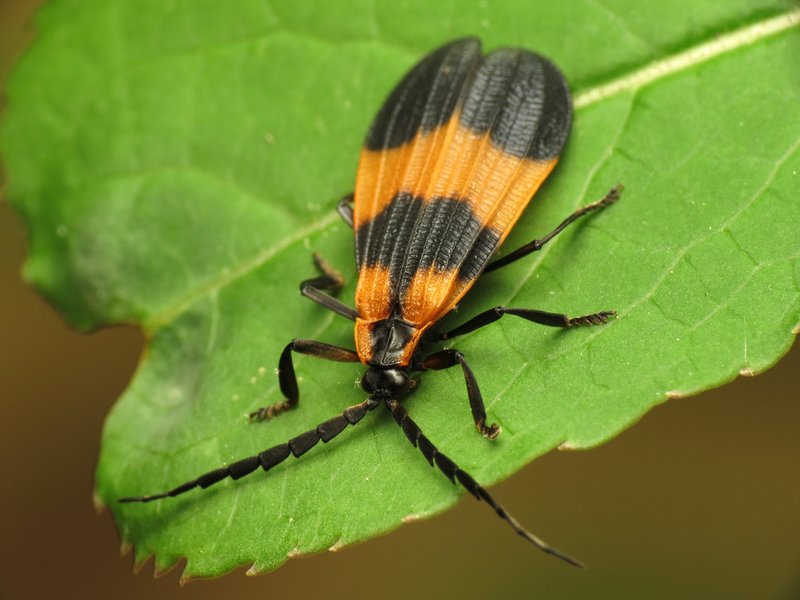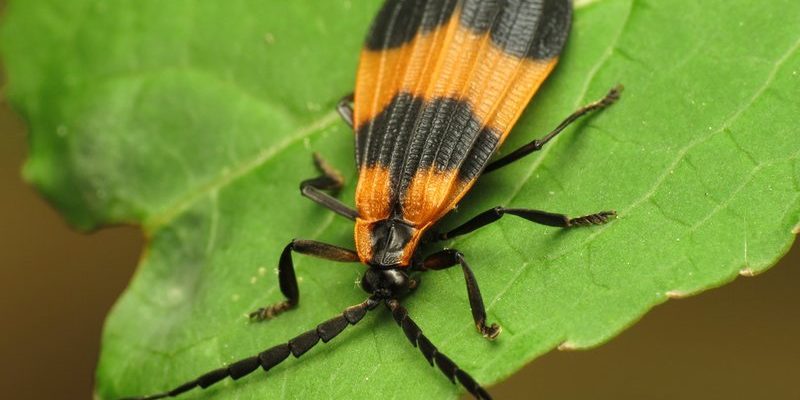
Have you ever stumbled upon a tiny insect that looks like it’s wearing a delicate lace dress? That’s likely a net-winged beetle! These fascinating little creatures are not only visually stunning but also play an intriguing role in their ecosystems. Found in various habitats across the world, net-winged beetles belong to the family Lycidae and have some unique characteristics that set them apart from other beetles.
Imagine walking through a lush forest or a blooming garden, and suddenly, a flash of bright colors catches your eye. Net-winged beetles are known for their vibrant hues and intricate wing patterns. These striking patterns aren’t just for show—they can help in communication and even in deterring predators. It’s a reminder that nature’s artistry is both beautiful and functional!
What Are Net-Winged Beetles?
Net-winged beetles are part of a broad group of insects that are easily identifiable by their distinctive membranous wings that resemble lace. This unique feature gives them an ethereal appearance, making them stand out among their insect peers. They are primarily found in temperate and tropical regions, where they enjoy a diverse range of environments—from lush forests to open fields.
These beetles are often mistaken for other insects due to their delicate wings and small size, but they are in a class of their own. One of the remarkable things about the net-winged beetle is their lifecycle. Like many beetles, they undergo complete metamorphosis, which includes four stages: egg, larva, pupa, and adult. Each stage has its own fascinating characteristics and needs.
Physical Characteristics
Net-winged beetles are known for their striking appearance. They typically boast a range of colors, including shades of red, yellow, orange, and black. Their wings, which are often transparent and net-like, provide them with a unique look that resembles intricate lacework. These adaptations help them evade predators while enhancing their display during mating rituals. Isn’t it interesting how aesthetics in nature often serve a purpose?
Their body shape is generally elongated and slender, allowing them to navigate through foliage and tight spaces easily. Adult net-winged beetles can vary significantly in size, with some measuring just a few millimeters long, while others can grow up to several centimeters. Regardless of their size, their vibrant colors and delicate wing patterns make them a delightful sight for anyone lucky enough to spot one.
Habitat and Distribution
Net-winged beetles thrive in a variety of habitats, including woodlands, grasslands, and gardens. They are commonly found in areas rich in leaf litter and decaying wood, where they can find plenty of food and shelter. This preference for diverse environments reflects their adaptability and resilience. You might find them hiding under leaves during the day, coming to life at dusk to fill the air with their gentle movements.
Geographically, net-winged beetles are distributed widely around the globe. They are especially prevalent in parts of North America, Europe, and Asia. Each region has its own specific species, showcasing how varied their adaptations can be based on local environmental conditions. For instance, some species have evolved to thrive in more arid regions, while others prefer the moist landscapes of tropical rainforests.
Diet and Feeding Habits
When it comes to dining, net-winged beetles are quite particular. As larvae, they are often predators, feeding on small soft-bodied insects like aphids and other pests. This behavior makes them beneficial for gardeners and farmers, as they help control pest populations naturally. If you’re tending to a garden, having these beetles around can be a boon!
As adults, their diet shifts a bit. They primarily feed on nectar, pollen, and decaying organic matter. This diet not only provides them with the energy needed for their activities but also links them to the health of their ecosystems. By pollinating plants while they feed, they contribute to the growth of more vegetation, creating a cycle of life that supports various other species.
Interesting Facts about Net-Winged Beetles
| Size: | 2mm to 25mm depending on species |
| Lifespan: | 1 to 2 years, depending on environmental conditions |
| Habitat: | Forests, grasslands, and gardens |
| Diet: | Nectar, pollen, and soft-bodied insects |
| Reproduction: | Eggs laid in leaf litter or decaying wood |
Behavior and Communication
Net-winged beetles exhibit some fascinating behaviors that help them survive and thrive. During mating season, males often showcase their vibrant colors and perform elaborate dances to attract females. This display is much like a peacock spreading its feathers, where the brighter and more elaborate the show, the more likely a male is to catch the attention of a potential mate.
They also communicate through a series of physical movements and postures. When threatened, some species can display defensive behaviors, like releasing a foul-smelling chemical to deter predators. This chemical is a powerful reminder of nature’s tactics for survival. It’s an effective strategy that many beetles employ to keep themselves safe!
Predators and Threats
Just like any other creature in the wild, net-winged beetles face their share of predators. Birds, frogs, and some larger insects are known to feast on them. Their colorful patterns may serve a dual purpose—dazzling potential mates while also warning predators that they might taste unappetizing. This dual strategy of attraction and defense is a brilliant example of evolutionary adaptation in action.
Moreover, habitat loss and environmental changes pose significant threats to their populations. As humans continue to develop land and use pesticides, the delicate balance of ecosystems where net-winged beetles thrive can be disrupted. Understanding the importance of these beetles can help us appreciate the roles they play and motivate conservation efforts.
Net-Winged Beetles in Culture
In various cultures, insects like net-winged beetles symbolize transformation and the beauty of nature. Their unique looks and behaviors have inspired artists, poets, and naturalists alike. Whether in art or literature, they often represent the delicate balance of ecosystems and the interconnectedness of all living things.
Additionally, these beetles serve as important indicators of environmental health. Their presence signifies a balanced ecosystem, while their absence may indicate underlying issues. By studying net-winged beetles, scientists can gain insight into the health of habitats and the impacts of climate change on biodiversity.
Conservation Efforts
With their critical role in ecosystems, it’s essential to focus on conservation efforts directed at net-winged beetles and their habitats. Promoting sustainable agricultural practices can help minimize pesticide use and encourage biodiversity. Creating awareness about the importance of these beetles in pollination and pest control can also boost conservation efforts.
Communities can engage in habitat restoration projects that focus on enhancing natural habitats for these beetles. Planting native flowering plants can provide food sources for adult beetles and help sustain their populations. By working together to conserve their natural habitats, we can ensure that future generations will continue to enjoy the beauty and ecological benefits of net-winged beetles.
FAQ
What is the lifespan of a net-winged beetle?
Generally, net-winged beetles have a lifespan that ranges from 1 to 2 years, depending on environmental factors like food availability and habitat conditions. Their lifecycle includes several stages, and the adult stage can last for a significant portion of their lives, especially during warm months when food is bountiful.
Do net-winged beetles play a role in pest control?
Yes, net-winged beetle larvae are predators and often feed on soft-bodied insects like aphids. This behavior makes them beneficial in agricultural settings, as they help control pest populations naturally, reducing the need for chemical pesticides.
How can I attract net-winged beetles to my garden?
To attract net-winged beetles, consider planting a variety of native flowering plants that provide nectar and pollen. Additionally, leaving areas of your garden un-mulched or allowing leaf litter to accumulate can create inviting habitats for these beetles.
Are net-winged beetles harmful to humans or pets?
No, net-winged beetles are not harmful to humans or pets. They are harmless insects that primarily feed on pollen and nectar. Their vibrant colors may be a warning to potential predators, but they do not pose any threat to us.
What do net-winged beetles eat?
Net-winged beetles have a diet that primarily consists of nectar and pollen as adults. As larvae, they are carnivorous and feed on smaller insects, helping control pest populations in their environment.
Where can I find net-winged beetles?
You can find net-winged beetles in various environments, including forests, gardens, and fields. They are particularly common in areas with plenty of flowering plants and decaying organic matter, which provide food and habitat.
Are net-winged beetles endangered?
While not all species of net-winged beetles are endangered, some populations face threats due to habitat loss and environmental changes. Conservation efforts are essential to maintaining their populations and the ecosystems they inhabit.
How do net-winged beetles reproduce?
Net-winged beetles reproduce by laying eggs in decaying wood or leaf litter. The larvae that hatch from these eggs will then feed on other small insects or organic matter, undergoing metamorphosis to become adults.
Can net-winged beetles be found in urban areas?
Yes, net-winged beetles can sometimes be found in urban areas, especially in gardens and parks that have maintained natural environments. Providing native plants and minimizing pesticide use can help attract them to urban gardens.

